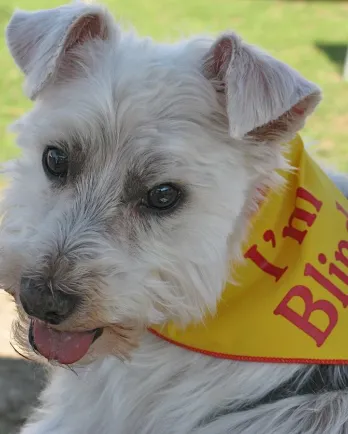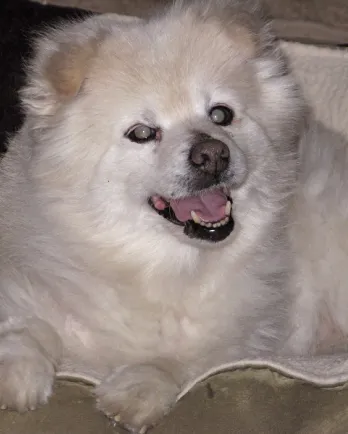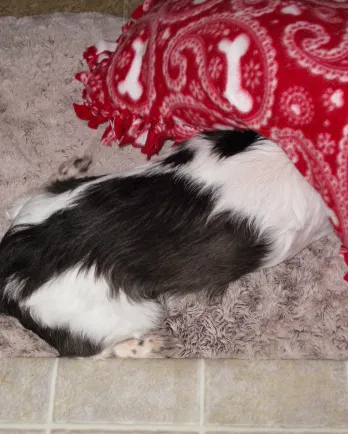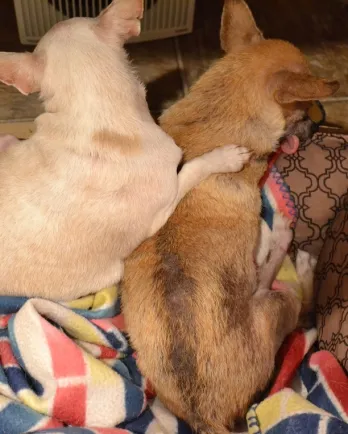Blind Dogs See With Their Hearts by Debbie Marks
I didn’t buy my first home until I was in my 40s, having rented prior to that. But I knew it was time to settle down, and I found the perfect home in upstate New York down the street from where I teach. I fenced in the yard and began looking for a dog. I was going to fill my home with dogs! So in came the rescued Bichons … first a senior from Texas, and then a bonded senior pair from Missouri. Frosty, Chip, and Baxter were wonderfully gentle and affectionate little boys who loved to cuddle. Chip could even do tricks! What fun we had! And all was well. But then it wasn’t.
Our vet noticed that Frosty’s eye pressures were somewhat high, and we saw an ophthalmologist. Frosty was diagnosed with glaucoma. For about a year, we were able to control his pressures with drops several times a day. But the time came when the pressure in one eye was no longer controllable, and Frosty was in continual pain. His eye was removed. A year later, his other eye had to be removed. Frosty was now completely blind.
Frosty began bumping into things in the home he’d been in for years. I had no idea how to help him. An online search led me to a blind dog owner support group on Yahoo, and they, in turn, led me to the Blind Dog Rescue Alliance (BDRA). They helped me to learn that blind dogs can, and do, have wonderful, active, exciting, and joyful lives, just like sighted dogs. I learned that being blind did not define Frosty, that he was still the same loving little boy he always was. I decided to volunteer. Maybe I could help someone else.
Blind Dog Rescue Alliance and a Dog Named Tex
BDRA formed in 2009 when a small group of people on the blind dog owner support group were discussing all of the blind dogs in shelters, and realized a rescue was needed. Work began in May, and on August 11, 2009, the incorporation paperwork was filed, making BDRA an official organization.
A dog named Tex, now Adam, has the distinction of being the first BDRA rescue. He is a sweet and playful pointer who is blind in one eye. Back in August of 2009, Tex was within hours of being euthanized at a Georgia shelter. Instead he is now with a loving family in Pennsylvania, who has also adopted a second BDRA dog. Since Tex, BDRA has rescued over 400 blind and visually impaired dogs. Coincidentally, dog #400, Bug, a Chihuahua/Jack Russell mix whose eyes were removed following a car accident, is also from a shelter in Georgia.
I joined BDRA in 2011. We are one of the few rescues in the US and Canada that specializes in visually impaired dogs of any breed, and sadly, there is a huge need. These amazing dogs are often at the top of a shelter’s list of dogs to be euthanized. Sometimes the visually impaired dogs don’t even get put out on the adoption floor because a shelter might not believe that they can have a good quality of life or will be adopted.
Dogs in shelters, dogs with owners who are unable to care for them any longer or who do not want a visually impaired dog, and even visually impaired dogs from other rescues have all come to BDRA. As a current volunteer on the Owner Surrender Team and a former volunteer on the Intake Team, I know firsthand that BDRA gets dozens of heartbreaking emails every day regarding visually impaired dogs in need of rescue.
For these reasons, educating the public is also a very important and equally necessary part of our mission. We receive many emails from owners whose dogs are going blind or have recently become blind, but are looking for advice and support, like I was for my Frosty. We’ve also received emails from other rescue or shelter foster homes who are looking for advice. Many of our volunteers do events in their local areas and find that the public sometimes isn’t aware that there is a rescue for blind dogs.
One of the first things I noticed about this wonderful rescue was that they didn’t shy away from placing the “senior seniors,” as I call them. I mean the ones with medical needs, sometimes severe, in addition to visual impairments. Nor did they shy away from placing dogs who are both blind and deaf.
Becoming a Foster for Blind Dogs
After I joined, I decided I very much wanted to be a foster, and so I went through BDRA’s foster process. I had my personal and vet references checked, and a home visit was completed. I was nervous about getting my first foster, but quickly volunteered to foster Tuffy, a completely blind Pomeranian with unregulated diabetes. How would I deal with a blind dog who’s never been here before? How would I “show” Tuffy the house?
While blind dogs adapt very well to almost any home situation, I have learned that there are some things you can do to make your home safe and comfortable for them. Check your home before bringing in a blind dog, or if your own dog has gone blind. You’ll need to gate the stairs, pool, and any other areas where he can fall and injure himself, and you’ll want to pad sharp corners or other obstacles, such as with pipe insulation. When introducing a blind dog into your home, as you would with any dog, be careful with your introductions because a blind dog cannot read another dog’s signals. I introduce a new foster to my current dogs through the chain link fence of my back yard.
I learned not to pick Tuffy up and put him down somewhere else, but to guide him to show him what I wanted him to know, such as where the water was or how to get outside. Otherwise, he had no idea how he arrived there. I learned to keep a new dog’s harness and leash on until he learns the lay of the land and I learn his behavior as well. I also started talking to my dogs – a lot - so they would always have a sense of where I was. I learned that, as much as I don’t like to see a dog bump, bumping is a normal part of a blind dog’s learning, or mapping, his surroundings. But one must always remember to protect him from sharp corners and other areas where he may get injured!
Some people use different textured mats to designate different areas, or safe areas, that the dogs can feel with their feet. For example, I use the rubber outside welcome mats to designate the "safe" path from the back door to the ramp and then to the lawn. Some people prefer to use scent. If you have other dogs, you may want to put jingly tags on them so the blind dog knows where they are and is not startled. I also learned to use vocabulary - in addition to the usual SIT and COME commands, etc., I also teach UP, DOWN (for steps up and down, curbs, etc.), and STOP (as an emergency word – a dog needs to stop right away). Some people also use RIGHT and LEFT and SLOW/EASY, so that he knows to go slowly and carefully as something is in his way. Whatever is most comfortable for you will work!
Blind dogs should not be left outside unsupervised, and recently, the BDRA board of directors has voted to prohibit the use of electronic/invisible fences. A blind dog also needs discipline, just like any other dog! But most of all, I have learned that a blind dog is a dog first, regardless of his blindness.
Going Grey with Leo and Maria
In 2012, we got word that an animal hospice was closing and many dogs and cats needed immediate rescue. Shortly after that, I drove to the hospice and picked up Leo and Maria. Leo, a terrier mix, and Maria, a Chihuahua, were both “senior seniors” at 16 ½ and 15 years old. Leo was blind and deaf, and Maria was blind. Both also had other health issues. Leo and Maria were welcomed into BDRA and into my open arms with lots of hugs and kisses. They became permanent residents.
When Leo and Maria first came, we thought they’d need nothing more than a warm bed for a few months. Boy, were we wrong! What personalities and such fighting spirits they had! And even though our hearts are broken as both have passed, how lucky we are – and always will be - to have known and loved such very special seniors. Leo, especially, was a very busy fellow, and scared me more than once with his daily antics. He even had his own Facebook page with more than 600 fans, which now features many of his friends!
I’ll never forget coming home one day and not being able to find Leo anywhere, shouting his name even though he was deaf, and thinking that someone must have broken in and stolen him. I looked for broken windows or open doors. I looked in closets and cabinets. I looked in the garbage. I was frantic. How could I explain to everyone that I lost Leo? I finally found him on the floor under a pillow that he had pulled off the couch. Only the tiniest bit of his tail was sticking out. I think my hair turned gray that day. It has never recovered.
Leo explored the world with his mouth, and he was particularly fond of shoes and books. I spent over three hours one night trying to tape together shreds of a book from the reading series we were using at school at the time. However, I quickly learned that even my struggling readers loved to read the books with Leo’s teeth marks!
And so I was hooked. I loved the seniors with medical needs.
Helping Claire Find Her Voice
In September of 2013, I saw a picture of Claire. Claire was the victim of a Kentucky hoarder. For her entire life, she lived in two rooms in knee-deep feces. She likely had litter after litter and was never vetted prior to rescue. A wonderful rescue, STAR, saved Claire and the other hoarder victims and helped them begin their long road to recovery. Claire’s picture went right through my heart and into my soul, and I asked BDRA if she could become a part of our forever foster/sanctuary program. She could.
Claire was a 14-year-old Chihuahua who had moderate renal failure (her bloodwork now is much better) and one tooth in the back. She could barely walk. Claire was severely infested with Demodex mange (she had no hair) and had several skin infections, as well as eye infections. And even though she had to be kept isolated for several weeks after she first arrived, I also welcomed Claire with open arms and hugs and kisses (and lots of changes of clothes), although she wasn’t so crazy about the kisses. And still isn’t.
In spite of everything she has gone through, Claire is a sweetheart who loves to be cuddled in a blanket and rocked. She loves to be talked to and loves to be sung to, if I don’t try to hit a high note. Well, actually, none of the dogs like that! She loves sleeping in a soft bed and making a nest, especially when her blankets are right out of the dryer. She loves to eat, even with one tooth. And she is very vocal and will sometimes join me in a song! She also has a wonderfully feisty side, and whether this is a result of her history or has always been part of her personality, I'm sure this served her well given where she came from. Her first tail wag brought tears to my eyes.
Claire is now 15 years old. Her beautiful red hair has come back, although there are areas of her skin that are severely scarred and will never have hair. She plays by barking and pawing at me, asking for cheese and cuddles, her two favorite things. She toddles through the house every day, looking for mischief (or maybe cheese). She does her best to be housebroken and potty outside. Her tail doesn’t stop wagging. And even though she still doesn’t like to get kisses, she is very generous about giving them. She also has friend, a one-eyed Chihuahua named CC. Claire brings sunshine into our lives every day.
Jake’s Second Chance
Jake is another BDRA forever foster/sanctuary dog who has been helped through Grey Muzzle’s grant. In November 2012, we were contacted by a shelter in Florida about a visually impaired senior Poodle/Maltese mix named Jake. He was also a certified hearing dog. Jake was surrendered to the shelter because his owners were elderly and not healthy. They were no longer physically able to care for him. In December, Jake joined BDRA.
As time went on, Jake’s foster family noticed he wasn’t feeling well. He had soft disc issues in both his back and neck, and had good days and bad days. His foster mom usually carried him around. Shortly after that, it was discovered that one of Jake’s kidneys was causing him discomfort. It turned out to be only a fluid filled sac, and completely non-functioning, so he had surgery to have the kidney removed. His foster mom reports that the difference in Jake is amazing! She thinks the issue with the kidney must have started not long after he arrived and it just continued to grow. She says that he is gorgeous and she feels so much better for him, given the change in how he looks and feels.
Because of the generous funding of The Grey Muzzle Organization, BDRA has been able to place seniors like Leo, Maria, Claire and Jake into our forever foster/sanctuary program. These dogs are BDRA’s permanent residents and will live in their foster homes forever. I love BDRA for taking them in, and I love The Grey Muzzle Organization for helping us to do that. Since 2009, 22 dogs have become BDRA forever fosters/sanctuary dogs, with six dogs, including Claire and Jake, currently in the program. I think that is truly amazing.
For more information, please visit our website or Facebook page at www.blinddogrescue.org and https://www.facebook.com/blinddogrescue, email info@blinddogrescue.com, or call 1-877-BLIND-01.
For additional information about The Grey Muzzle Organization's grant recipients, including Blind Dog Rescue Alliance, visit Who We Help.
The Grey Muzzle Organization improves the lives of at-risk senior dogs by providing funding and resources to animal shelters, rescue organizations, sanctuaries, and other nonprofit groups nationwide.






